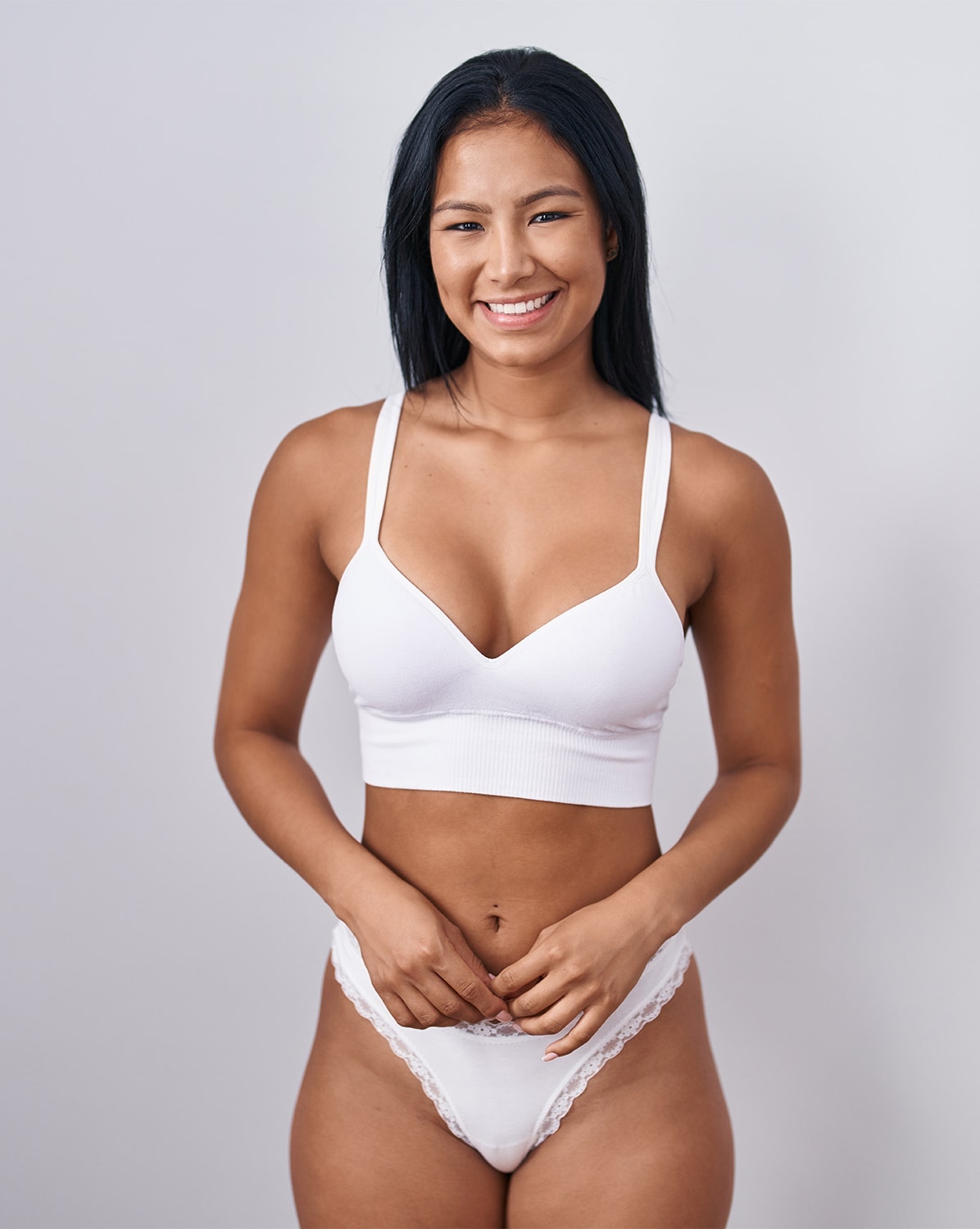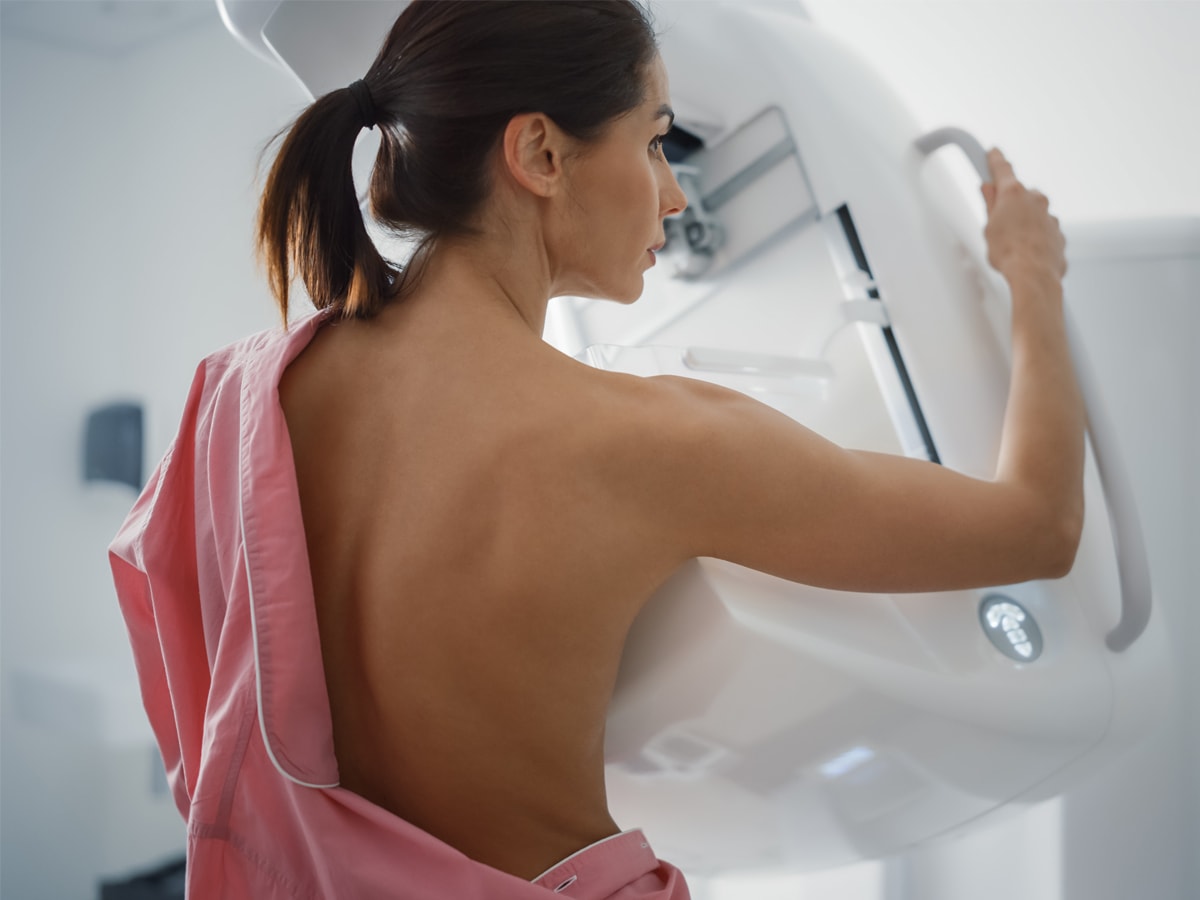Breast augmentation, also known as augmentation mammoplasty, is a surgical procedure to enhance the size and shape of a woman’s breasts. Every year, it continues to be one of the most popular cosmetic procedures performed in the United States. Using saline or silicone breast implants, our board-certified plastic surgeon, Dr. Neil J. Zemmel, can tailor the breast augmentation procedure to create a fuller breast appearance with highly natural-looking results.
This page will give you a basic understanding of the procedure, including who the proper candidates are, how it’s performed, what results you can expect, and more. Each person has individual circumstances, which may affect their final outcome, and Dr. Zemmel can answer all of your specific questions at your complimentary consultation.
- Breast Augmentation Benefits
- Breast Augmentation Candidates
- Choosing the Best Breast Surgeon
- Breast Augmentation Consultation
- Breast Implant Types
- Breast Implant Sizing
- How Anatomy Affects Augmentation
- Breast Implant Placement
- Breast Augmentation Incisions
- How Should I Prepare?
- Breast Augmentation Procedure
- Breast Augmentation Recovery
- Breast Augmentation Risks
- Breast Augmentation Scars
- Breast Augmentation Results
- Preventing Capsular Contracture
- Mammograms with Breast Implants
- Breast Augmentation Cost
- Breast Augmentation FAQs

What Are the Benefits of Breast Augmentation?
Breast augmentation is among the plastic surgery procedures with the highest patient satisfaction ratings. Many women experience an immediate improvement in their self-esteem and discover a greater self-confidence. The breast augmentation procedure is often sought after for a number of reasons; some of the most common benefits include:
- Enhance the breast contour of a woman who feels her breast size is too small
- Correct a reduction in breast volume after pregnancy and breast-feeding
- Balance a difference in breast size
- Reconstruct the breast following cancer surgery
How Do I Choose the Best Breast Augmentation Surgeon?
Choosing the right breast augmentation surgeon is crucial for achieving the best results. Above all, it is important to ensure your surgeon is board certified by the American Board of Plastic Surgery, as this indicates they have undergone rigorous training and meet high standards of care and safety in plastic surgery. In addition, you should find a plastic surgeon who specializes in breast augmentation and has extensive experience performing the procedure. By doing so, you can make sure they are familiar with different techniques, effectively tailoring the surgery to meet your specific needs.
Breast augmentation before-and-after photos can also be highly beneficial in your search for the best surgeon, as they can help you gauge the physician’s work and aesthetic style. To learn about other patients’ experiences with a plastic surgeon, read online reviews and testimonials to learn what you might be able to expect should you choose them for your care. Once you have narrowed down your search, you can schedule a consultation to discuss your goals and assess the surgeon’s communication and approach.
Confirm that the surgery will be performed in an accredited facility, and choose a surgeon who provides a customized plan tailored to your anatomy and preferences. Ensure you feel comfortable and confident in the surgeon’s abilities and transparency, and check that they offer comprehensive post-operative care. Selecting a qualified and experienced surgeon will help ensure you achieve your desired results safely and effectively.
What Can I Expect in My Breast Augmentation Consultation?
Breast augmentation requires careful pre-op consideration and decision-making. Dr. Zemmel begins this process with a careful initial consultation, assessing the history of any prior breast disease, prior pregnancies, breastfeeding, and breast surgeries. It is also important to assess any family history of breast disease or breast cancer. In addition, future mammography is an important consideration during the evaluation process.
During this consultation, Dr. Zemmel will evaluate your health and explain which surgical techniques are most appropriate for you. A careful physical examination is essential since the characteristics of each woman’s breast—such as size, shape, symmetry, skin quality and thickness—have a significant impact on the final result. The position of the breast on the chest wall and the position of the nipple on the breast also greatly influence the final result. Other factors include chest wall size, shape of the breast bone, patient height and weight, and any spinal scoliosis. If your breasts are sagging, Dr. Zemmel may also recommend a breast lift.
The cornerstone of Dr. Zemmel’s approach is to tailor treatment to your individual goals and circumstances. He will also ensure that you have a complete understanding of the issues involved so that you are able to make a fully informed decision. This will help you achieve the appearance you desire with the least invasive procedure available. Dr. Zemmel strives to have open, honest communication with you at all times. He believes this is the foundation of a solid doctor-patient relationship.
Be sure to discuss your expectations frankly with Dr. Zemmel, and he will be equally honest with you, describing the alternatives as well as the risks and limitations of each approach. Let Dr. Zemmel know if you smoke or take any medications, vitamins, or other drugs, as these may all affect your outcome. He will go over the details of your surgical plan, explaining the type of anesthesia to be used, the type of facility where the surgery will be performed, and the costs involved.
Traveling from out of town? Our practice is happy to coordinate consultations for individuals that may require additional planning and travel to our Richmond location. Dr. Zemmel’s patients come from all over the United States and abroad to receive first-class cosmetic enhancements in fully licensed and accredited facilities with board-certified surgeons and anesthesiologists.
At the completion of your consultation, you will be given a written estimate of the cost of your procedure. At this time, you will also have the option to schedule your procedure if you so choose. The decision to undergo surgery is a very important one and should be given very careful consideration. Dr. Zemmel realizes the importance of this decision, and at no time will you be pressured to commit to the procedure. You are also encouraged to bring your spouse, significant other, family member, or a friend to your consultation.

What Are the Different Types of Breast Implants?
-
Saline vs. Silicone Breast Implants
All breast implants consist of a silicone shell inflated with a filler material. The name of the implant designates the type of filler material. Saline implants are a silicone shell filled with salt-water solution. Saline is found throughout the body in all tissues and is harmless when absorbed.
Silicone gel implants are filled with gel silicone, and typically provide a more natural texture and feel. A more form-stable version of silicone implants is the “gummy bear” implant, which contains a highly cohesive silicone gel. These implants are designed to maintain their shape if a rupture occurs, decreasing the risk of a leak.
If you are interested in a specific type of implant, Dr. Zemmel will help you determine if they are right for you. He will explain the pros and cons of each in detail during your consultation.
-
Smooth vs. Textured Implant Surfaces
Breast implants may have a smooth surface or may have a rough, textured surface. The textured implants were designed with the goal of decreasing the rate of forming a scar around the implant, known as a capsular contracture. This does appear to be effective, but only when the implant is placed above the pectoralis muscle of the chest wall (see Submuscular Implant Placement, below). Textured implants have never been shown to provide any advantage over smooth implants when placed beneath the muscle of the chest wall.
Textured implants also have their own disadvantages. Textured implants are manufactured by taking a smooth implant shell and applying the texturing to the outer surface. This texturing process makes the shell slightly thicker and stiffer, which translates into an implant that is more visible through the skin and is more easily felt when the breast is touched. Because of these disadvantages and because most implants are placed beneath the muscle, the great majority of breast implants used today are of the smooth variety.
Dr. Zemmel believes that the smooth-surfaced implants provide a much more natural look and feel when compared to textured implants.
-
Round vs. Anatomically Shaped vs. High Profile
Most breast implants used today by Dr. Zemmel are round and smooth. These implants provide excellent shape, contour, and volume restoration. There are also implants that are teardrop shaped, called anatomic implants. These implants are designed to better simulate the shape of the natural breast. They provide more volume in the upper portion of the breast. In certain select cases these may be recommended, but all anatomical implants are textured and, therefore, are subject to some of the disadvantages of textured implants. Anatomic implants may also rotate position over time, changing the shape of the breast. This does not occur with a round implant, which is a symmetric disc.
Dr. Zemmel also uses a newer type of implant called a high-profile implant. These new implants allow a higher volume to be achieved with a smaller diameter implant. Women with smaller chest wall widths can therefore achieve the same breast volume as women with larger chest wall sizes. Depending on the shape of your chest, you may be a candidate for these new implants and may achieve an improved shape and more natural appearance. Some women who also need a breast lift may avoid this extra procedure with the use of a high-profile implant.
How Do I Choose the Right Size of Breast Implants?
This is one of the most important decisions you will make. Dr. Zemmel will use his 20 years of experience with thousands of cases to guide you through the process of choosing a size that can meet your goals. Dr. Zemmel uses several approaches to help you make the best decision based on your anatomy, personal preferences, and the appearance you desire. Most patients undergoing breast augmentation have the goal of achieving a “C”; a “D” cup tends to be the second most popular request.
Looking at Before-and-After Pictures
Dr. Zemmel will begin talking with you at length about your goals and desires. He will also show you examples of his patients’ breast augmentation before-and-after pictures. By finding someone who has a similar pre-operative appearance and evaluating their results, you will get an idea of whether or not you like the size they chose. You may wish to bring photographs from magazines or websites to better communicate to Dr. Zemmel the exact size, shape, and “look” you are trying to achieve.
Taking Measurements to Create a Natural Look
Several key measurements of your natural breast and chest shape will be taken. This gives Dr. Zemmel an idea of what size implant will help you meet your goals. As implant size increases, so does the diameter of the implant. There is an implant that will perfectly match the diameter of your natural breast, and that is a good starting point for discussion. Choosing an implant smaller than your natural breast shape will not provide the proper cleavage and shape following the procedure. Similarly, choosing an implant too large for your natural chest shape is more likely to give you an unnatural appearance.
CCs vs. Cup Size: How Breast Implants Are Measured
Unfortunately, implants do not come in cup sizes. Rather, they are categorized by the volume of saline (salt water) or silicone that they are designed to hold. There are several reasons for this. First, your final cup size will be partially determined by your pre-operative breast size, and everyone is different in this regard. Secondly, a “C” cup from one bra manufacturer is not necessarily the same as a “C” cup from another manufacturer. Everyone is built differently and bras are not manufactured to a set standard.
If you are of average height and build, you can expect that one cup size is approximately 200cc. If you are tall or have broad shoulders, you can expect that number to be slightly higher. Similarly, if you are more petite or have a narrower chest wall, you can expect that number to be slightly lower.
Although a desire for a certain cup size is helpful to Dr. Zemmel in guiding you in the selection of the proper implants, it is more helpful to focus on the shape and appearance that you wish to achieve.
“Trying On” Breast Implants
Finally, Dr. Zemmel will have you “try on” various demo implants in a surgical bra. You may wish to bring a bathing suit, tank top or other clothing to see how you will look with different implant sizes. This helps confirm that you are making the right implant choice. Dr. Zemmel will have you perform the “trying on” during the pre-operative visit. He also offers VECTRA® 3D imaging to further help you visualize what your final results may look like. This computer imaging technology allows Dr. Zemmel to digitally alter your photos to simulate the projected outcome of using different implant sizes on your frame.
The initial consultation is very thorough, lasts approximately one hour, and tends to provide you with a tremendous amount of information to digest. Dr. Zemmel will see you again at least one more time before surgery and you will have the opportunity to try on the sizers again before making a final decision. Our goal and the measure of our success is your happiness.

Placing Breast Implants Over vs. Under the Muscle
Breast augmentation involves surgical placement of the breast implants either over the pectoralis muscle (subglandular) or underneath (submuscular). Dr. Zemmel typically prefers to place implants beneath the pectoralis muscles to enhance breast size and shape, as this limits implant edge visibility. In addition, he finds this technique reduces the tendency to show visible wrinkling of the breast implant and gives a much more natural look and feel.
-
Subglandular Implant Placement
Implant placement over the muscle in the subglandular position puts the implant in complete contact with the breast tissue. This typically results in a more rounded augmented look, which some women prefer. The advantages of this technique include ease of the surgery, which can be accomplished by almost any surgeon; avoidance of a breast lift, although one is usually needed later; and less post-operative discomfort, since only skin and breast tissue are operated on.
This approach allows for the insertion of oversized implants, which is what some women desire. Disadvantages are marked interference with mammograms, clear visibility and feel of implant edges, visible and palpable rippling of the skin over the implants (especially with any textured implants), higher rate of capsular contracture, high rate of downward migration or “bottoming-out,” and difficulty correcting later sagging problems when they occur. Dr. Zemmel rarely recommends placing the implants over the muscle.
-
Submuscular Implant Placement
Submuscular implant placement is when the implant is mostly covered with the pectoralis muscle. This can be accomplished through an areola (nipple) incision, an inframammary, or transaxillary incision. This allows the implant to be covered at its uppermost aspect by muscle, while only the lower part of the implant is covered by breast tissue.
This has many advantages including separating the implant from the breast tissue, allowing for minimal interference with future mammography and breast diagnostics. The breast is recontoured at the upper pole, which hides the edge of the implant. Submuscular placement also allows the breast to form a natural “tear-drop” configuration and reduces the rate of capsular contractures. Dr. Zemmel performs nearly all breast augmentation procedures via this technique.
“Dr. Neil Zemmel and staff have been absolutely wonderful from my first consultation, through the insurance process, Pre Op, Surgery, and Post Op.”
Where Are Breast Augmentation Incisions Made?
Dr. Zemmel usually accomplishes submuscular placement of breast implants via a periareolar, inframammary, or transaxillary (armpit) approach. While all three approaches can provide excellent enlargement of the breast with enhancement in contour, each technique has its unique benefits.
-
Inframammary Technique
The inframammary technique is the oldest and most traditional technique. It uses a small 2.5 cm (approximately one inch) incision placed in the lower breast fold. This is the crease where the breast meets the chest wall. The approach provides the most direct access for placing the implant in the submuscular pocket. The breast tissue itself is not operated on, and therefore the chance of altering nipple sensation is significantly less. It allows easy access to the pectoralis muscle for release. This approach also has an extremely low complication rate.
The scars typically heal very well, and at 6 to 12 months after surgery becomes a fine line well hidden in the breast fold from the frontal view. Most women can hide the faded scar when in a normal bikini. The scars, however, may be slightly visible when lying down nude as the breast moves higher on the chest wall. This approach can be used in most women who desire a primary breast augmentation without a breast lift.
-
Periareolar Technique
The periareolar technique uses a small 3 cm incision located around the bottom of the areola (the dark skin around the nipple). The incision is placed at the juncture between the areolar and chest wall skin to hide it. The scars from this incision heal very well. The main benefit of this approach is that the incision is located in a very inconspicuous location and can be covered even with the most revealing clothing. It also provides excellent access to the submuscular pocket.
Because the breast tissue itself is operated on, the risks of alterations in nipple sensation are greater. This approach can also be used in women desiring primary breast augmentation or women who require a breast lift. Women must have a large enough diameter nipple/areola in order to benefit from this technique.
-
Transaxillary Technique
The transaxillary approach uses a small 2 cm incision located in the deep fold of the armpit. The most important benefit of this technique is that the breast is left without any incisions. The armpit scar, however, may be visible when in a tank top or in a bikini as the arms are raised. Dr. Zemmel will consider performing this technique if requested by a patient.
How Should I Prepare for My Breast Augmentation?
Dr. Zemmel will give you instructions to help you prepare for surgery, including guidelines on eating and drinking, when to stop smoking, and taking or avoiding certain vitamins and medications. While making the necessary preparations, be sure to arrange for someone to drive you home after your surgery and to help you out for a few days, if needed.
What Does the Breast Augmentation Procedure Involve?
Breast augmentation can be performed with general anesthesia, so you’ll sleep through the entire operation. Some surgeons may use a local anesthesia, combined with a sedative to make you drowsy, so you’ll be relaxed but awake, and may feel some discomfort. Please consult with Dr. Zemmel on which type of anesthesia you prefer.
The method of inserting and positioning your implant will depend on your anatomy and Dr. Zemmel’s recommendation. The incision can be made either in the crease where the breast meets the chest, around the areola (the dark skin surrounding the nipple), or in the armpit. Every effort will be made to assure that the incision is placed so resulting scars will be as inconspicuous as possible.
Working through the incision, Dr. Zemmel will lift your breast tissue and skin to create a pocket, either directly behind the breast tissue or underneath your chest wall muscle (the pectoral muscle). The implants are then centered beneath your nipples. Dr. Zemmel will discuss the pros and cons of each surgical approach with you, and together you will decide which method is best.
The surgery usually takes one to two hours to complete. Stitches are used to close the incisions, which may also be taped for greater support. A gauze bandage may be applied over your breasts to help with healing. You will be placed in a soft surgical bra for additional support.

What Can I Expect After Breast Augmentation?
You’re likely to feel tired and sore for a few days following your surgery, but you’ll be up and around in 24 to 48 hours. Dr. Zemmel will prescribe pain medication and antibiotics after surgery. Within several days, the gauze dressings, if you have them, will be removed, and you will continue to wear the surgical bra. The mild swelling and bruising should subside in 10 to 14 days. The sutures used to close the two small incisions will be absorbable and underneath the skin, so they will not need to be removed.
You may be able to return to work within a few days, depending on the level of activity required for your job. Dr. Zemmel will instruct you on when to begin exercises and normal activities. Your breasts will probably be sensitive to direct stimulation for two to three weeks, so you should avoid much physical contact. After that, breast contact is fine once your breasts are no longer sore, usually three to four weeks after surgery.
Routine mammograms should be continued after breast augmentation for women who are in the appropriate age group, although the mammographic technician should use a special technique to assure that you get a reliable reading, as discussed earlier.
What Are the Risks of Breast Augmentation?
When performed by a board-certified plastic surgeon, such as Dr. Zemmel, breast augmentations are typically considered a safe procedure. The extensive training, skills, and qualifications required for this status ensure your surgery is being performed under high safety and care standards. With that said, all surgical procedures come with certain risks—including bleeding, infection, or a negative reaction to anesthesia—although these generally occur in less than one percent of patients. Other complications that may occur more specific to breast augmentation can include implant leakage, rupture, or rippling, changes in nipple sensation, implant malposition, capsular contracture (scar tissue that hardens and contracts around the implant), and breast implant illness.
Dr. Zemmel takes extreme care to reduce any potential risks by conducting thorough health and candidacy assessments as well as performing all surgeries in fully licensed and accredited facilities. During a consultation, he will review all potential risks so there is a clear understanding of both the limitations and benefits of breast augmentation prior to the procedure.
What Will My Breast Augmentation Scars Look Like?
You can expect your scars to be firm and pink for at least six weeks. Then they may remain the same size for several months, or even appear to widen. After several months, your scars should begin to fade, although they will never disappear completely.
A common concern for some patients, such as African American women, is the fear of heavy scarring (also known as hypertrophic scarring) or keloid scarring (pathologic scarring). These terms are used interchangeably, but they represent separate physiologic processes.
- Hypertrophic Scars: These are a normal outcome in some patients, and reflect the physiologic response to healing. Factors that influence the production of hypertrophic scars are the tightness of the surgical incision, the location of those scars on the body, and the individual’s own genetic tendencies. Hypertrophic scars are limited to the area of injury, and are particularly prone to occur on the shoulders, knees, and breast bone areas.
- Keloid Scars: This is a genetically inherited disorder in which scars heal with an extremely robust response. The scar grows outside of the original confines of the wound. Keloids are uncommon and may be difficult to treat. Some keloids respond to steroid injections. Keloids are common on the ears, neck, and over the breastbone—they are less common on the breasts. If you have a tendency to keloid, you are probably not a candidate for a cosmetic operation.

How Can I Prevent Capsular Contracture?
One of the most common complications of breast augmentation is the development of a foreign body reaction called capsular contracture. Any foreign material placed within the body will cause a reaction. All materials including suture, silicone, metals, and plastics cause a thin scar to form around the implant separating it from the rest of the body. The scar attempts to place the implant in the smallest volume possible by contracting. In most patients (greater than 98%) the scar remains thin and soft and undetectable. In a small minority of patients, the foreign body reaction is more robust and the capsular scar is thicker. Dr. Zemmel uses several ways to limit the amount of scar production before, during, and after surgery.
Refrain from Smoking
First, it is essential to maximize the potential for wound healing by providing optimal amounts of oxygen and nutrients to the wound. Smoking impairs wound healing and should be stopped at least 4 weeks prior to surgery to ensure the best results.
Limit Germs and Bacteria
It is also important to limit the amount of bacterial contamination around the implant. Dr. Zemmel observes the strictest sterile technique in the operating room to reduce the amount of bacteria around the implant. It is important to limit potential germ contamination at the time of surgery by adequate pre-op hygiene. Dr. Zemmel will instruct you to take a thorough shower the morning of surgery (using regular soap), and avoid shaving the armpits for a transaxillary approach for one week prior to surgery. This prevents ingrown hairs in the surgical field. A strong antibacterial prep is done at surgery with strict avoidance of germ contamination during the operation.
Special Surgical Technique
Dr. Zemmel creates an oversized submuscular pocket that is significantly larger than the implant, which allows the implant more room to form a capsule. This helps reduce the chance of a tight scar forming directly around the implant causing a visible or palpable scar.
Massage Your Breast Implants
Finally, Dr. Zemmel instructs all patients to begin early, vigorous post-operative massage of the implants, fully displacing them throughout the entire oversized submuscular pocket. This is used to keep the implant pockets wide open, soft, and freely moveable. This will eventually give a natural feel and appearance to the breast.
How Are Mammograms Performed with Breast Implants?
Prospective candidates over age 40 should receive yearly mammograms in accordance with the guidelines of the American Cancer Society. How breast augmentation may interfere with future mammography must be considered throughout treatment.
For this reason, Dr. Zemmel prefers submuscular placement of breast implants, which has no significant impact on breast self-examination or mammograms. After breast augmentation, women must obtain mammograms at centers experienced in using specialized Eklund displacement views.

How Much Does Breast Augmentation Cost?
Breast augmentation costs an average of $7,700 to $8,200 at Richmond Aesthetic Surgery. Since every patient receives a surgical plan tailored to their unique needs and aesthetic goals, this cost will vary for each individual.
Our team will provide you with a quote by the end of your consultation based on your treatment plan, helping you budget for your procedure. Insurance companies do not consider breast augmentation to be medically necessary, and carriers generally do not cover the cost of this procedure.
Additional Frequently Asked Questions About Breast Augmentation
Will I Need a Lift with My Breast Augmentation?
For patients considering breast augmentation that are also experiencing sagging breasts (ptosis), a breast augmentation with lift, or augmentation mastopexy, may be recommended. The effects of drooping breasts may be categorized by different levels of the breast dropping below the crease underneath the breast (inframammary fold) and/or nipples that point downward. Additionally, a breast lift can remove excess, inelastic skin that may impact the results of a breast augmentation by itself. For the right candidates, a breast augmentation with lift can provide an overall more shapely, fuller, perkier, and youthful aesthetic outcome.
Are There Alternatives to Breast Implants?
Breast augmentation without implants may also be achieved using a fat transfer technique, which extracts fat from other areas of the body to be inserted into the breasts. Also referred to as a “natural” breast augmentation, a fat transfer provides a more subtle enhancement for those that would like to increase their breasts up to one cup size. During the procedure, targeted fat cells are removed from virtually any area of the body (abdomen, thighs, arms, etc.), harvested and purified, and then reinserted into the breasts for a fuller, more voluptuous shape. It is important to note that it may take multiple fat transfer procedures to achieve the desired breast size, as not all fat cells will survive the fat transfer process.
How Long Do Breast Implants Last?
Breast implants made with high-quality, durable materials are designed to last an average of 10 to 20 years. The full lifetime of implants may vary based on the type (silicone or saline), surrounding breast tissue, and lifestyle habits. If any complications arise, such as feelings of discomfort, tightening, or hardening, you should contact your doctor or surgeon right away. Additionally, if a noticeable difference in volume is detected, there may be a leak or rupture that should also be seen by your surgeon. These types of changes are usually covered under the implant manufacturer’s warranty for a breast implant revision procedure. Routine MRI’s and exams are also recommended to monitor the health and longevity of breast implants.
What Is the Best Age for Breast Augmentation?
Candidacy for breast augmentation procedures is less about age and more about the patient’s physical health and expectations. However, there are some limitations based on the type of implant placed. Per FDA requirements, individuals must be 18 years of age for saline implants and 22 years of age for silicone implants. Beyond that, our patients are usually between their 20s and 40s, if not older. Each patient will require a health evaluation to ensure they are in good health and able to safely recover from surgery, as well as have realistic expectations of the breast augmentation outcome and what it can achieve for their unique cosmetic goals.
Should I Be Concerned About Breast Implant Illness?
Breast Implant Illness (BII) is a term used by some women who have breast implants and experience a variety of symptoms they believe are related to their implants. While BII is not a recognized medical diagnosis, some women report symptoms such as fatigue, joint pain, and brain fog. Dr. Zemmel understands these symptoms can affect a woman’s quality of life, and he takes them very seriously.
Research on the connection between breast implants and BII symptoms is ongoing, and current evidence does not conclusively link breast implants to these health issues. However, it is important to listen to your body and discuss any concerns with your surgeon. Most women with breast implants do not experience significant health problems and are extremely satisfied with their results.
If you have concerns about BII or are experiencing symptoms, Dr. Zemmel can help you explore your options, which may include breast revision surgery to remove or replace your implants. Open communication with your surgeon and regular follow-ups are essential to ensuring your well-being and peace of mind.


